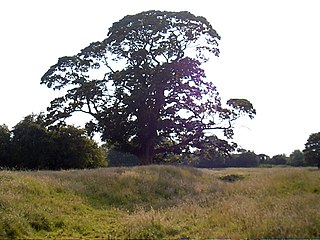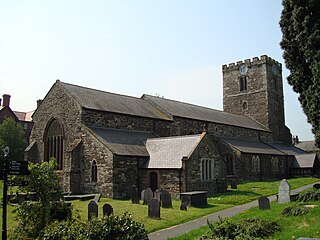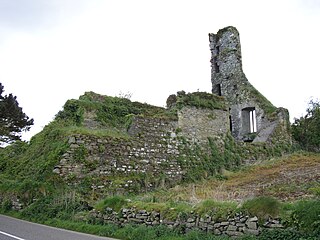
Neath Abbey was a Cistercian monastery, located near the present-day town of Neath in South Wales, UK. It was once the largest abbey in Wales. Substantial ruins can still be seen, and are in the care of Cadw. Tudor historian John Leland called Neath Abbey "the fairest abbey of all Wales."

Meaux Abbey was a Cistercian abbey founded in 1151 by William le Gros, 1st Earl of Albemarle, Earl of York and 4th Lord of Holderness, near Beverley in the East Riding of Yorkshire, England.

Aberconwy Abbey was a Cistercian foundation at Conwy, later transferred to Maenan near Llanrwst, and in the 13th century was the most important abbey in the north of Wales.

Great Coxwell Barn is a Medieval tithe barn at Great Coxwell, Oxfordshire, England. It is on the northern edge of the village of Great Coxwell, which is about 9 miles (14 km) northeast of Swindon in neighbouring Wiltshire.

Kamp Abbey, also known as Altenkamp Abbey or Alt(en)feld Abbey was the first Cistercian monastery founded in German territory, in the present town of Kamp-Lintfort in North Rhine-Westphalia.

Wąchock Abbey is a Cistercian abbey in Wąchock, Poland. Located near the larger town of Starachowice in the Świętokrzyskie Mountains of south-eastern Poland, Wąchock is best known for the architecture of this Roman Catholic site.
Hugh of Beaulieu was a medieval English Bishop of Carlisle.

Abbeymahon Abbey, also known as The Cistercian Abbey of St Mary de Fonte Vivo, and as the Abbey of Sancto Mauro is a ruined medieval Cistercian abbey situated near Timoleague, County Cork, Ireland.

Stratford Langthorne Abbey, or the Abbey of St Mary's, Stratford Langthorne was a Cistercian monastery founded in 1135 at Stratford Langthorne — then Essex but now Stratford in the London Borough of Newham. The Abbey, also known as West Ham Abbey as it lay in that parish, was one of the largest Cistercian abbeys in England, possessing 1,500 acres (6.07 km2) of local land, controlling over 20 manors throughout Essex. The Abbey was self-sufficient for its needs and wealthy besides; some of this wealth came from the ecclesiastic mills grinding wheat for local bakers to supply bread to the City of London. This later led to competition with the Guild of Bakers, who sought powers to levy a toll on loaves entering the City at Whitechapel.

Great Coxwell is a village and civil parish 2 miles (3 km) southwest of Faringdon in the Vale of White Horse, England. It was in Berkshire until the 1974 boundary changes transferred it to Oxfordshire. The 2021 Census recorded the parish's population as 295 in 124 households.

Little Coxwell is a village and civil parish in South East England, about 1.5 miles (2.4 km) south of Faringdon and 0.8 miles (1.3 km) east of Great Coxwell. Little Coxwell was part of Berkshire until the 1974 local government boundary changes transferred the Vale of White Horse to Oxfordshire. Cistercian monks of Beaulieu Abbey built the Church of England parish church of Saint Mary in the 12th century as a chapel of ease. Little Coxwell was a dependent chapelry of the ecclesiastical parish of Great Faringdon. In 1866 the civil parish was established. The village has a public house, the Eagle Tavern. The Hurlingham Polo Association, the governing body for polo in the UK, Ireland, and many other countries, has its office at Manor Farm, Little Coxwell.

Eastminster, also known as New Abbey, St Mary Graces, and other variants, was a Cistercian abbey on Tower Hill at East Smithfield in London. It was founded by Edward III in 1350 immediately outside the Roman London Wall in what is now the London Borough of Tower Hamlets. It stood just to the north of an older royal foundation, the Hospital and Collegiate Church of St Katharine by the Tower.
Hazleton Abbey was an abbey at Hazleton in Gloucestershire, England.
Wyresdale Abbey was a short-lived medieval monastic house in Over Wyresdale, Lancashire, England. It was founded around 1170 or a little later and ceased to exist by 1204.
Swineshead Abbey was an abbey in Swineshead, Lincolnshire.
The St. Mary of the Gospel Monastery is located just six kilometers from the mountain town of Jarabacoa, La Vega, in the Dominican Republic.
Overlade is a village/town in western Himmerland, Denmark, with a population of 427, located 12 km north from Farsø, 16 km south of Løgstør, 3 kilometers from Limfjord and seven kilometers south of Ranum. The village is located in the North Denmark Region and belongs to the Vesthimmerland Municipality. The village was founded by the monks of Vitskøl Abbey most likely the monks were from the Cistercian Order. The village has in recent history been a rich business with several factories, forges, bakeries, butcher sale, bicycle shop and much more. The village inn burned down in 1984. Like many small towns, some of these businesses through time has gone, but the town still has some shops and craft stores.











